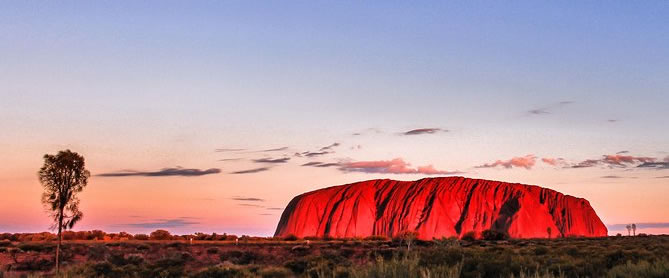Uluru | Ayers Rock |

Uluṟu-Kata Tjuṯa National Park
Uluru is Australia's proud symbol, and site of spiritual significance for the Anangu people.
Uluru is the local Anangu, Pitjantjatjara people and traditional name for the landmark. Ayers Rock is the English name in honour of the then Chief Secretary of South Australia, Sir Henry Ayers.
In 1993, a dual naming policy was adopted of both the traditional Aboriginal name and the English name. On 15 December 1993, it was renamed "Ayers Rock / Uluru". It was was officially reversed to "Uluru / Ayers Rock"on 6 November 2002.
Like an iceberg, it's believed that only a third of the big red rock lies above ground.
What we can see measures 3.6 km (2.5 miles) long, 348 meters (1,141 feet) tall, so Uluru is an awfully big rock. Ayers Rock is known for its fabulous colors at dawn and sunset, when the pitted rock surface turns from ocher brown to a rich burnished orange.
Walking tracks lead around the base of the rock, ranging from easy 45-minute strolls to the circumnavigation which can take up to four hours and passes caves, paintings and sacred sites.
The Anangu people ask visitors not to climb their sacred rock, and it is a dangerously steep and windy ascent.
Instead, taking a tour led by the Anangu is a very rewarding experience, as is visiting their cultural center to learn the Dreamtime stories and cultural significance of the site.
❊ Address ❊
⊜ Uluṟu-Kata Tjuṯa National Park Peterman 0872 View Map
❊ What's On ❊
Coming to Uluru | Ayers Rock..➼ Climb Uluru - Closed
➼ Uluru | Kata Tjuta National Park Tickets
❊ Web Links ❊
➼ Uluru | Ayers Rock
❊ Also See.. ❊
➼ Ayers Rock Resort
➼ SkyShip Uluru
Update Page











